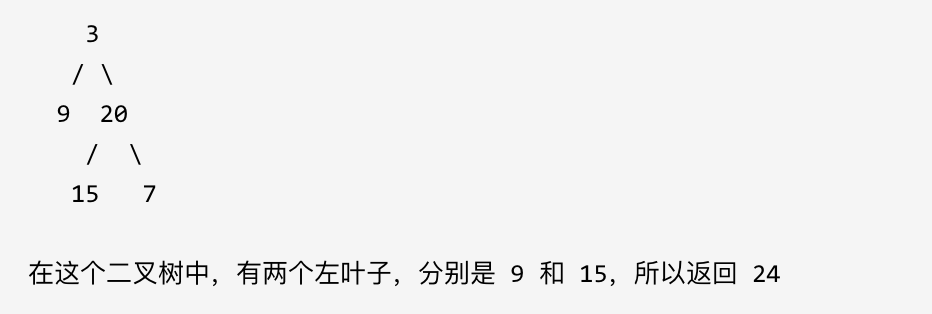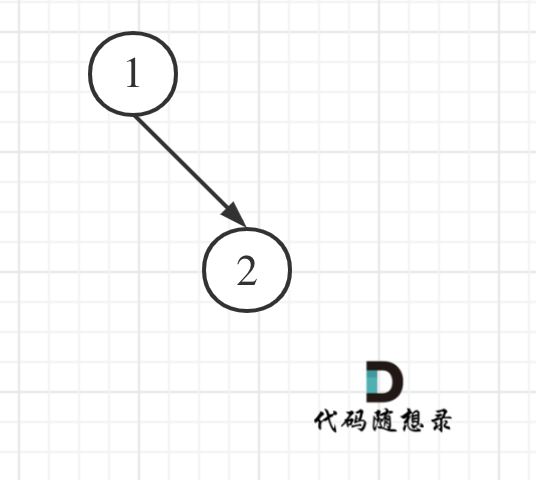参与本项目,贡献其他语言版本的代码,拥抱开源,让更多学习算法的小伙伴们收益!
计算给定二叉树的所有左叶子之和。
示例:
首先要注意是判断左叶子,不是二叉树左侧节点,所以不要上来想着层序遍历。
因为题目中其实没有说清楚左叶子究竟是什么节点,那么我来给出左叶子的明确定义:如果左节点不为空,且左节点没有左右孩子,那么这个节点的左节点就是左叶子
大家思考一下如下图中二叉树,左叶子之和究竟是多少?
其实是0,因为这棵树根本没有左叶子!
那么判断当前节点是不是左叶子是无法判断的,必须要通过节点的父节点来判断其左孩子是不是左叶子。
如果该节点的左节点不为空,该节点的左节点的左节点为空,该节点的左节点的右节点为空,则找到了一个左叶子,判断代码如下:
if (node->left != NULL && node->left->left == NULL && node->left->right == NULL) {
左叶子节点处理逻辑
}
递归的遍历顺序为后序遍历(左右中),是因为要通过递归函数的返回值来累加求取左叶子数值之和。。
递归三部曲:
- 确定递归函数的参数和返回值
判断一个树的左叶子节点之和,那么一定要传入树的根节点,递归函数的返回值为数值之和,所以为int
使用题目中给出的函数就可以了。
- 确定终止条件
依然是
if (root == NULL) return 0;
- 确定单层递归的逻辑
当遇到左叶子节点的时候,记录数值,然后通过递归求取左子树左叶子之和,和 右子树左叶子之和,相加便是整个树的左叶子之和。
代码如下:
int leftValue = sumOfLeftLeaves(root->left); // 左
int rightValue = sumOfLeftLeaves(root->right); // 右
// 中
int midValue = 0;
if (root->left && !root->left->left && !root->left->right) {
midValue = root->left->val;
}
int sum = midValue + leftValue + rightValue;
return sum;
整体递归代码如下:
class Solution {
public:
int sumOfLeftLeaves(TreeNode* root) {
if (root == NULL) return 0;
int leftValue = sumOfLeftLeaves(root->left); // 左
int rightValue = sumOfLeftLeaves(root->right); // 右
// 中
int midValue = 0;
if (root->left && !root->left->left && !root->left->right) { // 中
midValue = root->left->val;
}
int sum = midValue + leftValue + rightValue;
return sum;
}
};以上代码精简之后如下:
class Solution {
public:
int sumOfLeftLeaves(TreeNode* root) {
if (root == NULL) return 0;
int midValue = 0;
if (root->left != NULL && root->left->left == NULL && root->left->right == NULL) {
midValue = root->left->val;
}
return midValue + sumOfLeftLeaves(root->left) + sumOfLeftLeaves(root->right);
}
};本题迭代法使用前中后序都是可以的,只要把左叶子节点统计出来,就可以了,那么参考文章 二叉树:听说递归能做的,栈也能做!和二叉树:迭代法统一写法中的写法,可以写出一个前序遍历的迭代法。
判断条件都是一样的,代码如下:
class Solution {
public:
int sumOfLeftLeaves(TreeNode* root) {
stack<TreeNode*> st;
if (root == NULL) return 0;
st.push(root);
int result = 0;
while (!st.empty()) {
TreeNode* node = st.top();
st.pop();
if (node->left != NULL && node->left->left == NULL && node->left->right == NULL) {
result += node->left->val;
}
if (node->right) st.push(node->right);
if (node->left) st.push(node->left);
}
return result;
}
};这道题目要求左叶子之和,其实是比较绕的,因为不能判断本节点是不是左叶子节点。
此时就要通过节点的父节点来判断其左孩子是不是左叶子了。
平时我们解二叉树的题目时,已经习惯了通过节点的左右孩子判断本节点的属性,而本题我们要通过节点的父节点判断本节点的属性。
希望通过这道题目,可以扩展大家对二叉树的解题思路。
递归
class Solution {
public int sumOfLeftLeaves(TreeNode root) {
if (root == null) return 0;
int leftValue = sumOfLeftLeaves(root.left); // 左
int rightValue = sumOfLeftLeaves(root.right); // 右
int midValue = 0;
if (root.left != null && root.left.left == null && root.left.right == null) {
midValue = root.left.val;
}
int sum = midValue + leftValue + rightValue; // 中
return sum;
}
}迭代
class Solution {
public int sumOfLeftLeaves(TreeNode root) {
if (root == null) return 0;
Stack<TreeNode> stack = new Stack<> ();
stack.add(root);
int result = 0;
while (!stack.isEmpty()) {
TreeNode node = stack.pop();
if (node.left != null && node.left.left == null && node.left.right == null) {
result += node.left.val;
}
if (node.right != null) stack.add(node.right);
if (node.left != null) stack.add(node.left);
}
return result;
}
}// 层序遍历迭代法
class Solution {
public int sumOfLeftLeaves(TreeNode root) {
int sum = 0;
if (root == null) return 0;
Queue<TreeNode> queue = new LinkedList<>();
queue.offer(root);
while (!queue.isEmpty()) {
int size = queue.size();
while (size -- > 0) {
TreeNode node = queue.poll();
if (node.left != null) { // 左节点不为空
queue.offer(node.left);
if (node.left.left == null && node.left.right == null){ // 左叶子节点
sum += node.left.val;
}
}
if (node.right != null) queue.offer(node.right);
}
}
return sum;
}
}递归后序遍历
class Solution:
def sumOfLeftLeaves(self, root: TreeNode) -> int:
if not root:
return 0
left_left_leaves_sum = self.sumOfLeftLeaves(root.left) # 左
right_left_leaves_sum = self.sumOfLeftLeaves(root.right) # 右
cur_left_leaf_val = 0
if root.left and not root.left.left and not root.left.right:
cur_left_leaf_val = root.left.val
return cur_left_leaf_val + left_left_leaves_sum + right_left_leaves_sum # 中迭代
class Solution:
def sumOfLeftLeaves(self, root: TreeNode) -> int:
"""
Idea: Each time check current node's left node.
If current node don't have one, skip it.
"""
stack = []
if root:
stack.append(root)
res = 0
while stack:
# 每次都把当前节点的左节点加进去.
cur_node = stack.pop()
if cur_node.left and not cur_node.left.left and not cur_node.left.right:
res += cur_node.left.val
if cur_node.left:
stack.append(cur_node.left)
if cur_node.right:
stack.append(cur_node.right)
return res递归法
func sumOfLeftLeaves(root *TreeNode) int {
var res int
findLeft(root,&res)
return res
}
func findLeft(root *TreeNode,res *int){
//左节点
if root.Left!=nil&&root.Left.Left==nil&&root.Left.Right==nil{
*res=*res+root.Left.Val
}
if root.Left!=nil{
findLeft(root.Left,res)
}
if root.Right!=nil{
findLeft(root.Right,res)
}
}迭代法
func sumOfLeftLeaves(root *TreeNode) int {
var res int
queue:=list.New()
queue.PushBack(root)
for queue.Len()>0{
length:=queue.Len()
for i:=0;i<length;i++{
node:=queue.Remove(queue.Front()).(*TreeNode)
if node.Left!=nil&&node.Left.Left==nil&&node.Left.Right==nil{
res=res+node.Left.Val
}
if node.Left!=nil{
queue.PushBack(node.Left)
}
if node.Right!=nil{
queue.PushBack(node.Right)
}
}
}
return res
}递归法
var sumOfLeftLeaves = function(root) {
//采用后序遍历 递归遍历
// 1. 确定递归函数参数
const nodesSum = function(node){
// 2. 确定终止条件
if(node===null){
return 0;
}
let leftValue = sumOfLeftLeaves(node.left);
let rightValue = sumOfLeftLeaves(node.right);
// 3. 单层递归逻辑
let midValue = 0;
if(node.left&&node.left.left===null&&node.left.right===null){
midValue = node.left.val;
}
let sum = midValue + leftValue + rightValue;
return sum;
}
return nodesSum(root);
};迭代法
var sumOfLeftLeaves = function(root) {
//采用层序遍历
if(root===null){
return null;
}
let queue = [];
let sum = 0;
queue.push(root);
while(queue.length){
let node = queue.shift();
if(node.left!==null&&node.left.left===null&&node.left.right===null){
sum+=node.left.val;
}
node.left&&queue.push(node.left);
node.right&&queue.push(node.right);
}
return sum;
};递归法
function sumOfLeftLeaves(root: TreeNode | null): number {
if (root === null) return 0;
let midVal: number = 0;
if (
root.left !== null &&
root.left.left === null &&
root.left.right === null
) {
midVal = root.left.val;
}
let leftVal: number = sumOfLeftLeaves(root.left);
let rightVal: number = sumOfLeftLeaves(root.right);
return midVal + leftVal + rightVal;
};迭代法
function sumOfLeftLeaves(root: TreeNode | null): number {
let helperStack: TreeNode[] = [];
let tempNode: TreeNode;
let sum: number = 0;
if (root !== null) helperStack.push(root);
while (helperStack.length > 0) {
tempNode = helperStack.pop()!;
if (
tempNode.left !== null &&
tempNode.left.left === null &&
tempNode.left.right === null
) {
sum += tempNode.left.val;
}
if (tempNode.right !== null) helperStack.push(tempNode.right);
if (tempNode.left !== null) helperStack.push(tempNode.left);
}
return sum;
};递归法
func sumOfLeftLeaves(_ root: TreeNode?) -> Int {
guard let root = root else {
return 0
}
let leftValue = sumOfLeftLeaves(root.left)
let rightValue = sumOfLeftLeaves(root.right)
var midValue: Int = 0
if root.left != nil && root.left?.left == nil && root.left?.right == nil {
midValue = root.left!.val
}
let sum = midValue + leftValue + rightValue
return sum
}迭代法
func sumOfLeftLeaves(_ root: TreeNode?) -> Int {
guard let root = root else {
return 0
}
var stack = Array<TreeNode>()
stack.append(root)
var sum = 0
while !stack.isEmpty {
let lastNode = stack.removeLast()
if lastNode.left != nil && lastNode.left?.left == nil && lastNode.left?.right == nil {
sum += lastNode.left!.val
}
if let right = lastNode.right {
stack.append(right)
}
if let left = lastNode.left {
stack.append(left)
}
}
return sum
}


